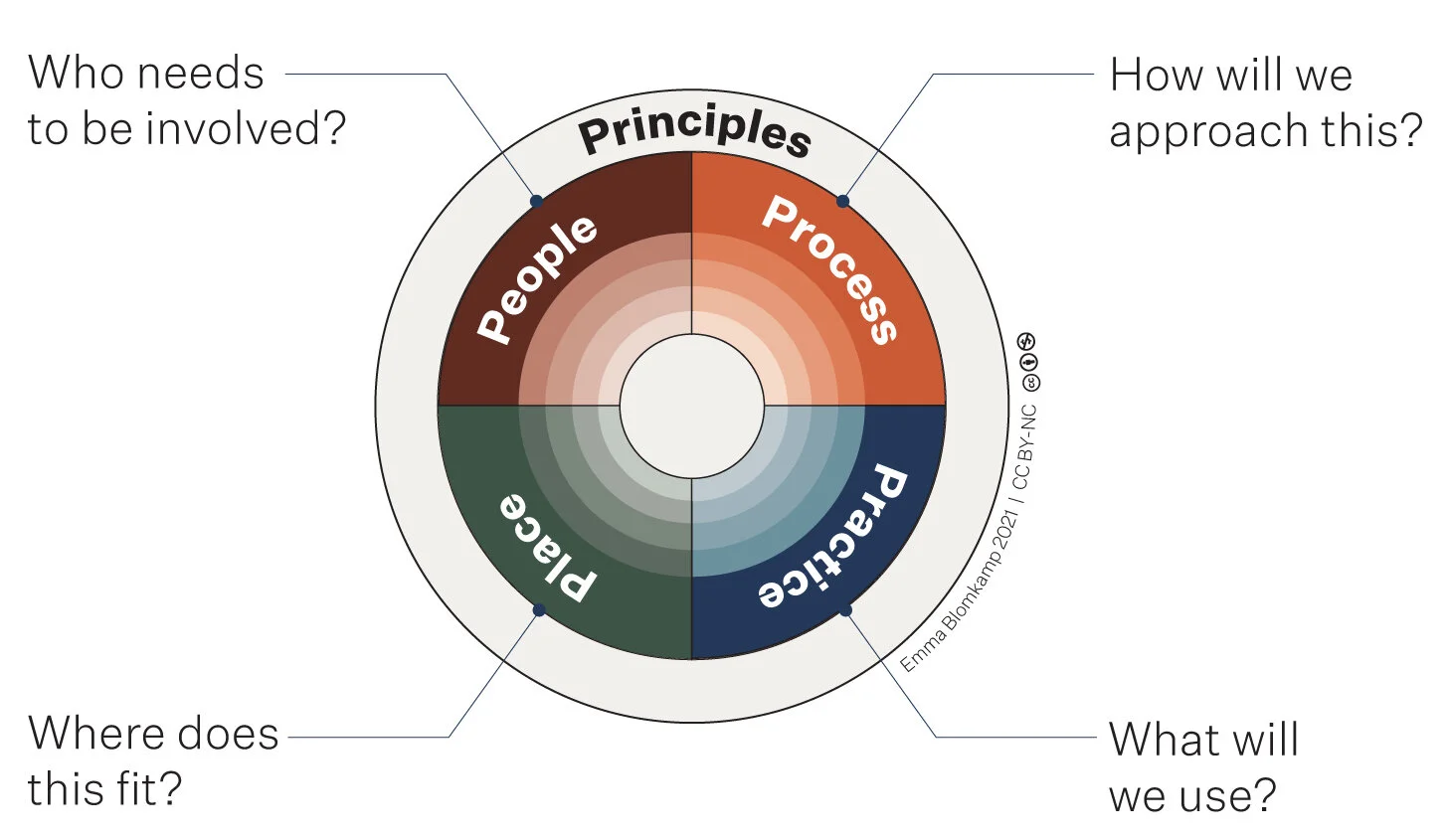
Systemic Design Practice Wheel
The Systemic Design Practice Wheel guides practitioners taking creative and participatory approaches to complex problems. Designed by Emma Blomkamp, it distills experience and knowledge from research, evaluation, education and practice in design for public and social innovation.
Building understanding and capability in systemic design
The five core domains of the Systemic Design Practice Wheel—principles, place, people, process and practice—cover the key considerations for people working with communities and stakeholders on shared challenges.
Systemic design is ‘a design-led practice that integrates dialogue in co-creation for sensemaking and decision making’.
(Jones 2018; Blomkamp 2021)
The “5 Ps” framework incorporates knowledge and experience in systems thinking, human-centred design and participatory design to articulate what needs to be taken into account when tackling complex problems and designing for social change.
The development of the Systemic Design Practice Wheel is described in an open access, peer-reviewed article in Policy Design and Practice.
Use and re-use
Designed to support practitioners, participants and supporters at key moments in systems change work, the framework and accompanying guidance presented here (as a PDF diagram and worksheet) is shared under a CC BY-NC licence.
This means the Systemic Design Practice Wheel is free for anyone to use, adapt and share for non-commercial purposes, as long as attributed to Emma Blomkamp (2021).
To offer feedback, suggestions for improvement, be notified of future iterations, or request use of the framework for other purposes, please contact me.
I use the Systemic Design Practice Wheel with clients and participants in various ways, including for:
project planning
practice reflection
capability and readiness assessments
reviewing and evaluating work
training and supervision
Want to learn more about how to use the Systemic Design Practice Wheel? Consider joining an upcoming course on Co-Design in Complex Systems.
Aside from the six principles, each domain has an overarching question and four key elements to consider.
Key questions for systemic design practice
The principles are the north stars, guiding all action. The principles I put forth are based on a synthesis of literature and practice.
Why and how does this work need to happen? What matters most?
Purpose-driven: What are our objectives/goals and desired outcomes? Why is this work important?
Inclusive collaboration: How can we best engage diverse participants? What conditions and resources are required for collaboration?
Self-determination: How are we respecting individual agency, rights and strengths? How are we supporting community-led action?
Equalising power: Whose voices and ideas are usually privileged and why? How might we rebalance power, distribute leadership and share decision-making?
Recognising complexity: How are we recognising and responding to the dynamic and interconnected nature of complex problems and systems?
Adaptive learning: When and how will our activities and outputs be tested, evaluated and iterated?
Principles
Place reminds us to always consider the local and nested contexts within which we are working, as well as the timing and level or scale of the work, and its connections with other activities and systems.
Where does this work fit? When is it happening? Which level are we working at?
Systems: Which environment/s, sector/s and system/s is this work situated within and seeking to change? What is the political, historical and sociocultural context?
Interactions: What relationships, initiatives or services might we change or create? What will people’s experience be like? How does this connect with other objects, activities, organisations and networks?
Products: What objects or artefacts might we create, for whom, and how will they be used?
Symbols: What visual language or brand guidelines will we use or create? How will we communicate about our work?
Place
Process encourages us to think about structures and movement that enable and constrain the work in different spaces and phases over time.
How will we structure and organise our approach? When will key moments take place?
The Systemic Practice Design Wheel highlights four key moments in the process:
Invitation: Is co-design right for us, right now? [Download PDF from Beyond Sticky Notes]
Preparation: What approach will we take? What conditions, capabilities, relationships and resources do we need?
Navigation: How and when can we care for, coordinate and communicate with the people interested and involved?
Completion: With whom and how will we close the loop, keep in touch, and share outputs and learnings?
Process
People highlights the individuals and groups involved, the different roles that need to be filled, and the importance of relationships and caring for those participating in and affected by the work.
Who needs to be involved? What do they bring? What do they need?
Self: What is my position in this work and this system?
Team: What roles and skills do we need? How will we support them/each other?
Organisation: What resources, expectations and requirements do the organisations involved have?
Community: Who will this impact? How and when will they be engaged in the work?
People
Practice encompasses the tasks, tools and techniques used in carrying out the work, and draws attention to the knowledge, skills and structures that support reflection and action.
What specific methods, techniques and tools will enable us to reach our objectives and follow our principles?
Tools: What materials or instruments might be useful for this particular technique or method?
Techniques: What activities, tasks, tactics or techniques will help us achieve our objectives? What skills are required to use the tools?
Methods: Which method, strategy, procedure or approach might we adopt? How will we build capability in these methods?
Principles: How will each principle guide our approach?
Practice
Systemic Design Practice Wheel © 2021 by Emma Blomkamp is licensed under CC BY-NC 4.0







